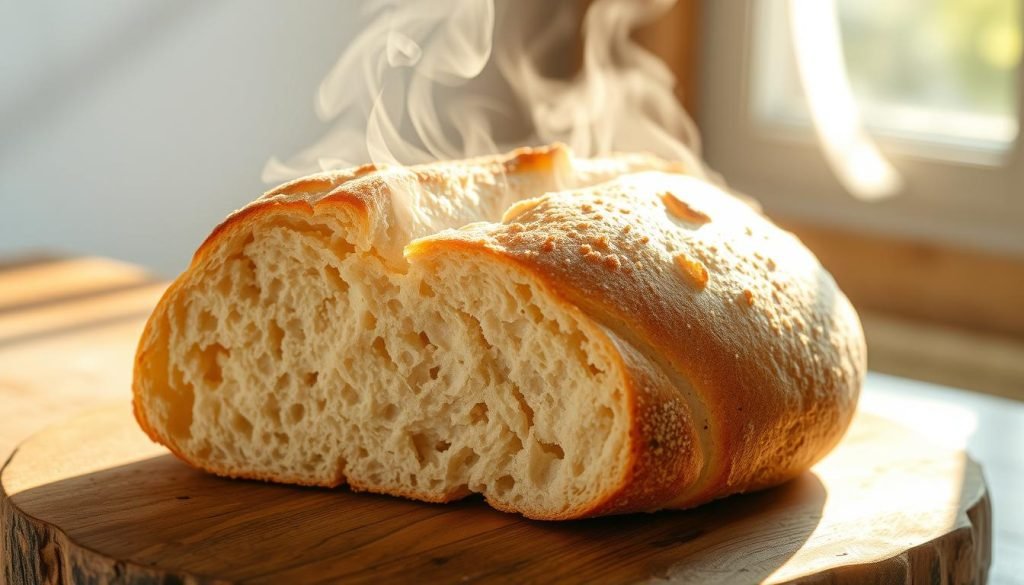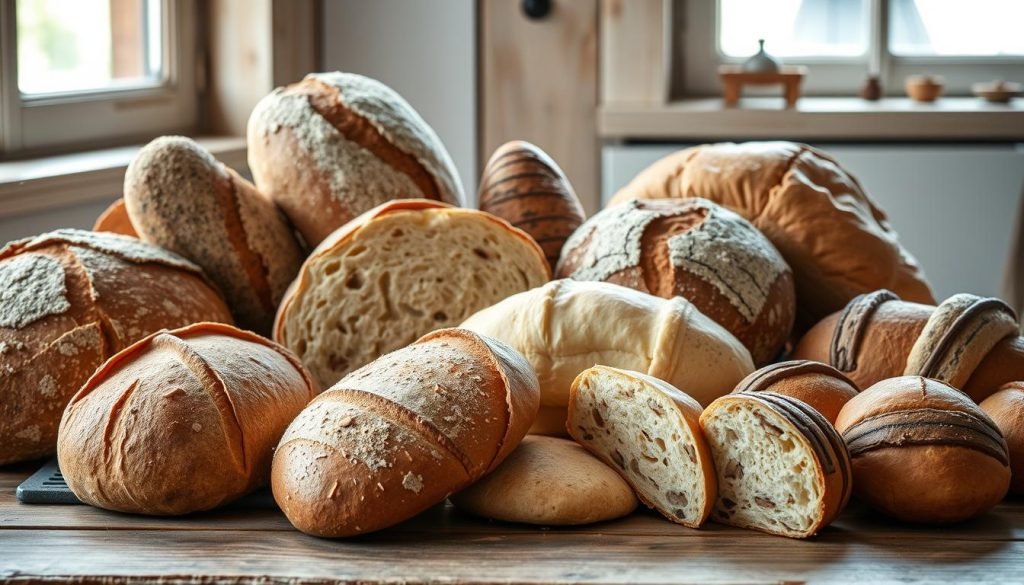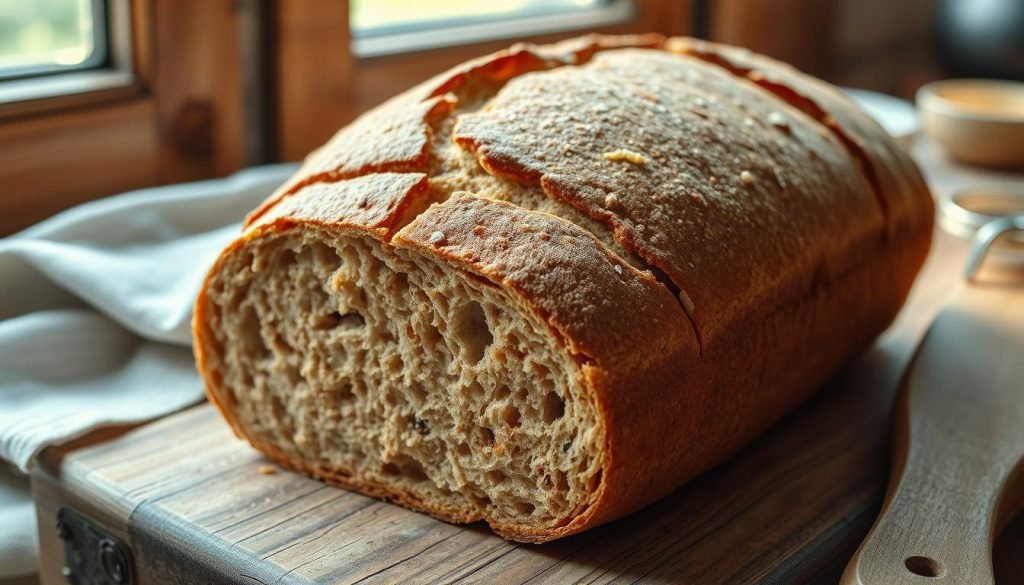Explore the World of Nordic Breads

Ever wondered why Nordic breads have won hearts for centuries? These dense loaves are more than food. They connect us to a deep cultural past that goes back to the Iron Age.
Get ready for a tasty trip into Nordic breads. You’ll find everything from thick rye loaves to crunchy flatbreads. These breads show off the creativity of Nordic bakers. Soon, you’ll see why these old recipes are loved everywhere.
In this guide, you’ll learn the secrets of the perfect crust. You’ll also discover the special ingredients that make Nordic breads taste so unique. Whether you bake often or just love food, there’s something here for you.
Key Takeaways
- Nordic breads have a history dating back to the Iron Age
- Rye bread is a staple in Scandinavian cuisine, known for its health benefits
- Nordic breads use a variety of whole grains and seeds
- Traditional baking techniques contribute to unique flavors and textures
- These breads are gaining popularity worldwide for their taste and nutritional value
What Are Nordic Breads?
Nordic breads are a key part of Scandinavian flavors. They have been around for thousands of years. These loaves give a unique taste that shows the region’s rich food history.
Definition and Overview
Nordic breads come from Denmark, Sweden, Norway, Finland, and Iceland. They use whole grains, like rye, and add seeds and nuts for taste and health. Rye bread has been important in Nordic food since the Iron Age, around 500 AD.
Historical Significance
Bread was very important in early Scandinavian societies. People ate up to 2 pounds of bread every day before the Industrial Revolution. Most bread was made from barley or rye, which grow well in cold weather.
Ancient Viking graves show bread with ingredients like linseed, oats, and pine bark flour.
| Time Period | Bread Consumption | Main Ingredients |
|---|---|---|
| Pre-Industrial Revolution | 1-2 lbs per person daily | Barley, Rye |
| Viking Age | Varied | Linseed, Oats, Pine Bark Flour |
| Modern Era | Less, but still significant | Rye, Wheat, Various Seeds |
Today, Nordic breads are still loved in Scandinavian cuisine. They mix tradition with new ideas in every slice. Whether it’s a dense rye loaf or a crisp flatbread, you’re tasting centuries of Nordic food culture.
Key Ingredients in Nordic Breads
Nordic breads are known for their healthy ingredients and strong flavors. They are full of nutrients and have a unique taste. Let’s explore what makes these breads special.
Whole Grains and Their Benefits
Whole grains are the base of Nordic breads. Rye flour is key, giving them a dense texture and earthy taste. Whole grain rye bread is tasty and full of fiber and nutrients.
Other grains used include:
- Barley
- Wheat
- Oats
- Buckwheat
These grains make the bread good for your heart. A Nordic bread recipe might use 250 grams of medium rye flour and 400 grams of extra rye flour for more texture.

Seeds and Nuts for Flavor
Seeds and nuts are important for flavor and nutrition in Nordic breads. They add crunch and depth. Common additions are:
| Ingredient | Amount per bread |
|---|---|
| Pumpkin seeds | 65g |
| Sunflower seeds | 65g |
| Whole almonds | 90g |
| Chia seeds | 25g |
These ingredients enhance flavor and add protein and healthy fats. For example, a recipe might include 170 grams of sunflower seeds. This adds a nice crunch and nutty flavor.
Nordic breads mix healthy ingredients for a great taste and nutrition. They are a great choice for a hearty and healthy bread.
Types of Nordic Breads You Should Try
Nordic cuisine has many breads, each with unique flavors and textures. You can find everything from dense rye breads to crispy flatbreads. There’s something for everyone.
Rye Bread Varieties
Rye bread has been a key part of Nordic diets since 500 AD. It’s known for its dense texture and strong flavor. Danish Rugbrød is a classic, often used for Smørrebrød sandwiches.
Swedish Limpa is also popular. It has a hint of sweetness, thanks to orange zest and spices like anise or caraway.
Rye bread is full of fiber, making it good for your heart. You can find Pumpernickel and Rugbrød at specialty bakeries. They sometimes offer them together for variety.
Crispbreads and Flatbreads
Knäckebröd, a Swedish crispbread, is simple yet tasty. It’s made from rye flour, water, and salt. Its crunchy texture is great for toppings or as a snack.
Norwegian Lefse is a soft flatbread, perfect for holidays. It’s made from potatoes, flour, and cream. This gives it a delicate texture that’s good with both sweet and savory toppings.
| Bread Type | Origin | Key Ingredients | Common Use |
|---|---|---|---|
| Rugbrød | Denmark | Rye flour, seeds | Smørrebrød base |
| Limpa | Sweden | Rye flour, orange zest, spices | Everyday bread |
| Knäckebröd | Sweden | Rye flour, water, salt | Snack or base for toppings |
| Lefse | Norway | Potatoes, flour, cream | Holiday treat |
Exploring Nordic breads can open up a world of flavors and textures. Whether you like the heartiness of rye or the crispness of flatbread, you’ll find something you love.
The Health Benefits of Nordic Breads
Nordic breads are great for your health. They are full of nutrients that help your body stay well.
Rich in Fiber
Whole grain bread, like rye, is common in Nordic diets. It has lots of fiber. This helps with digestion and keeps you feeling full.

Rye bread also has a low glycemic index. This helps keep blood sugar levels steady. It’s good for your long-term health.
Nutrient-Dense Options
Nordic breads are full of good stuff. Whole rye has vitamins B and E, magnesium, and iron. These help your body work right and fight off sickness.
Many Nordic breads also have seeds like flaxseed and sunflower seeds. These add healthy fats and extra vitamins and minerals. Flaxseeds are special because they have omega-3 fatty acids. These are good for your heart and might help prevent some cancers.
| Nutrient | Benefit |
|---|---|
| Dietary Fiber | Improves digestion, promotes fullness |
| Vitamins B and E | Boosts energy production, supports immune function |
| Omega-3 Fatty Acids | Protects heart health, may reduce cancer risk |
| Magnesium and Iron | Essential for various bodily functions |
Adding Nordic breads to your diet is good for you. You get to enjoy tasty flavors and get lots of health benefits.
Essential Baking Techniques for Nordic Breads
Learning how to bake Nordic bread is crucial. It helps you get the real taste and texture. We’ll look at the basic steps, like making sourdough starters and kneading and proofing.

Sourdough Starter Basics
Sourdough starters are key in Nordic bread. Start by mixing equal parts of flour and water in a jar. Every day, add fresh flour and water, throwing away half each time.
In about a week, you’ll have a starter that’s bubbly and active. It’s then ready for baking.
Proper Kneading and Proofing Methods
Kneading methods differ for each dough. For doughs rich in rye, gently fold it to avoid toughening the gluten. Doughs with more wheat need longer kneading.
Proofing is vital for the right rise. Rye breads take longer to proof, while wheat breads proof quicker.
| Bread Type | Kneading Time | Proofing Time |
|---|---|---|
| Rye Bread | 5-10 minutes | 2-4 hours |
| Wheat Bread | 10-15 minutes | 1-2 hours |
| Mixed Flour Bread | 8-12 minutes | 1.5-3 hours |
With these techniques, you can make delicious Nordic bread at home. Remember, the more you practice, the better you’ll get at making sourdough and other Nordic breads.
Regional Variations of Nordic Breads
Nordic food traditions are full of bread varieties. Each one shows the unique taste of its region. As you explore Scandinavian cuisine, you’ll see how breads differ across countries and landscapes.
Scandinavian Differences
In Denmark, rye bread is the king. Bakers made huge loaves, up to 35 pounds, to save fuel. Sweden loves crispbreads, and Norway enjoys flatbreads like lefse for holidays.

Icelandic Influences
Iceland’s bread traditions are interesting. By the 17th century, rye and barley were key. A special Icelandic bread is made in hot springs, taking 24 hours to bake. This makes a dense, sweet loaf that’s truly Icelandic.
Nordic breads show the variety in Scandinavian cuisine. From Finnish Ruisreikäleipä, rye bread rings, to Swedish sourdough crispbreads, each country has its own bread.
| Country | Dominant Grain | Signature Bread |
|---|---|---|
| Denmark | Rye | Dense rye loaves |
| Sweden | Mixed grains | Crispbreads |
| Norway | Barley, Oats | Lefse (flatbread) |
| Iceland | Rye, Barley | Hot spring rye bread |
| Finland | Rye | Ruisreikäleipä |
Learning about these differences helps you appreciate Nordic food’s rich heritage. It shows how bread is a big part of Scandinavian cuisine.
Pairing Nordic Breads with Foods
Nordic food lovers know that the right pairings can make Scandinavian cuisine even better. Rye bread, a key part of Nordic diets, is great for many toppings and sides. Let’s look at some tasty ways to enjoy these hearty breads.
Perfect Spreads and Toppings
Nordic breads are amazing with traditional spreads. Try these tasty options:
- Danish remoulade
- Swedish kaviar
- Butter topped with fresh herbs
- Lingonberry jam
For a true taste of Scandinavian cuisine, make open-faced sandwiches called smørrebrød. Layer your rye bread with smoked salmon, cucumbers, and dill for a classic mix.

Complementing Meats and Cheeses
Rye bread goes well with many meats and cheeses. Try these combinations:
- Aged Gouda with thinly sliced ham
- Creamy Brie with prosciutto
- Smoked trout with cream cheese
- Hard-boiled eggs with caviar
For a quick and healthy snack, spread cream cheese on crisp knekkebrød and add cucumber slices. This bread keeps well for weeks, making it great for sudden get-togethers.
Remember, Nordic breads are more than just a base for toppings. They’re a key part of the culinary experience, offering a rich, nutty flavor that goes well with many foods. Try different combinations to find your favorite pairings and explore the wide world of Nordic food.
Where to Buy Nordic Breads in the United States
Craving authentic Nordic breads? You’re in luck! The U.S. market for Scandinavian cuisine is growing. Now, you can find more options for rye bread and other Nordic specialties. Let’s explore where you can find these delicious loaves.
Local Bakeries and Artisan Shops
Many cities now have bakeries that specialize in Nordic breads. In New York, Nordic Breads bakes 10,000 loaves of rye bread weekly. Their organic Finnish Ruis Bread is made with 100% organic rye flour.
This bread is a superfood, full of fiber and antioxidants. You can find it at New Amsterdam Market and Whole Foods.
Online Retailers Worth Exploring
Can’t find a local bakery? Online retailers have got you covered. NORDIC EXPAT SHOP offers worldwide delivery of Danish bread products. They have many options, including white, whole grain, gluten-free, rye, and crisp breads.
| Shipping Option | Cost | Delivery Time |
|---|---|---|
| Standard U.S. | Varies | 2 business days |
| 1-Day Shipping | $35.00 | 1 business day |
| Alaska/Hawaii | $29.99 extra | Varies |
| International (Canada) | $29.99 | Varies |
Nordic breads are more than just food. In Denmark, 98% of homes have bread. 56% eat it for breakfast, and 64% for lunch. It’s a staple in Scandinavian cuisine, perfect for making traditional dishes like Danish Smørebrød. So why wait? Start your Nordic bread adventure today!

Simple Nordic Bread Recipes to Try at Home
Ready to dive into Nordic baking? Let’s explore some delicious bread recipes. They bring Scandinavian flavors right to your kitchen. These recipes are perfect for both beginners and experienced bakers alike.
Classic Rye Bread Recipe
Danish Rye Bread, or rugbrød, is a staple in Scandinavian diets. This hearty loaf combines dark rye flour, bread flour, and a 7-grain cereal mix for added texture. Here’s a simplified version you can try:
- 2 cups (248g) dark rye flour
- 2 cups (295g) bread flour
- 1 tsp (3g) instant yeast
- 2 ⅔ cups (613g) cold water
- 1 ½ cups (353g) additional cold water
Mix ingredients, let rise for 1½-3 hours, then bake at varying temperatures for about 75 minutes. Cool for at least 3 hours before slicing. This rye bread keeps well at room temperature for 5 days or frozen for months.

Quick Crispbread Recipe
For a faster Nordic bread option, try this quick crispbread recipe:
- 2 dl whole wheat flour
- 4.5 dl all-purpose flour
- 1 dl sunflower seeds
- 1 dl flax seeds
- ½ dl sesame seeds
- 50g black poppy seeds
- 5 dl buttermilk
- 1 tbsp honey or malt syrup
- ½ tbsp salt
Mix dry ingredients, add wet ingredients, and stir until combined. Spread thinly on a baking sheet and bake at 180°C (360°F) for about 20-25 minutes or until crisp. Break into pieces once cooled.
These Nordic bread recipes offer a taste of Scandinavian baking traditions. Experiment with different seeds and grains to create your perfect loaf!
Cultural Importance of Bread in Nordic Countries
Bread is key in Scandinavian cuisine. It’s not just food; it’s a symbol of culture and community. Traditional breads hold deep meaning in these countries.

Tradition and Community
Bread-making in the Nordics goes back centuries. Rye, a main grain, has been important in Finnish food for over 2,000 years. Finnish rye bread is simple, with just four ingredients: water, leaven, salt, and rye flour.
Many Finnish families keep sourdough leaven for generations. Some are over 50 years old. This shows the bond between bread and family in Nordic countries.
Bread in Nordic Celebrations
Bread is big in Nordic celebrations and everyday life. In Sweden, Fika is about socializing over coffee and cake. Holidays bring special breads, often with cinnamon or fresh berries.
In Finland, bread is a national treasure. Finns take rye bread and Fazer chocolate when traveling. This shows their love for traditional breads.
| Country | Traditional Bread | Characteristics |
|---|---|---|
| Denmark | Rugbrød | Dark rye bread, typically made with sourdough |
| Sweden | Knäckebröd | Round crispbread made from wholemeal wheat and dark rye |
| Finland | Ruisleipä | Popular rye bread with variations like limppu and reikäleipä |
| Iceland | Flatbrauð | Flatbread made from rye flour and hot water |
How to Store Nordic Breads for Freshness
Keeping your Nordic breads fresh is key to enjoying their unique flavors and textures. Whether you’re savoring homemade sourdough bread or store-bought rye bread, proper storage can make a big difference in taste and longevity.
Best Practices for Storage
For short-term storage, consider using a bread bin with a tight seal. These containers can keep your bread fresher longer compared to leaving it out. Prices for bread bins range from $20 to $70, catering to different budgets and styles. Some even double as cutting boards, offering added functionality.
If you don’t have a bread bin, wrap your bread in cloth or paper. Avoid plastic, as it can trap moisture and lead to mold. For crusty loaves, store them cut-side down on a cutting board to preserve their texture.

Freezing for Long-Term Use
For longer storage, freezing is your best bet. Slice your bread before freezing to make it easier to thaw only what you need. Wrap individual portions tightly in plastic wrap or foil, then place in a freezer bag. Frozen bread can last up to three months.
When you’re ready to eat, thaw slices at room temperature or toast them directly from frozen. This method works well for both homemade bread recipes and store-bought varieties, including rye bread and sourdough bread.
Remember, refrigerating bread can actually speed up staleness, so it’s best to avoid this method. With these storage tips, you’ll be able to enjoy your Nordic breads at their best for longer periods.
Join the Nordic Bread Movement!
Ready to explore Nordic bread? You’re in for a treat! Scandinavian cuisine is now popular worldwide. People like Simo Kuusisto in New York and many in the U.S. are excited about it.
Discover Local Workshops
Want to improve your baking? Local workshops are a great place to start. Bakeries and schools teach Nordic bread making. You’ll learn to make Danish rye, perfect sourdough, and make Icelandic flatbreads.
These hands-on classes let you dive into Nordic baking traditions.
Engage with Online Communities
Can’t find a local class? No problem! Online communities are here for you. Sites like EYBDigital have thousands of recipes, like Pear, Sage, and Hazelnut Bread. Share your successes, ask for help, and meet others who love Nordic food.
Whether you’re making a rustic lingonberry loaf or trying Finnish tosca cake, you’re welcome. So, put on your apron, heat up the oven, and start exploring Scandinavian baking!